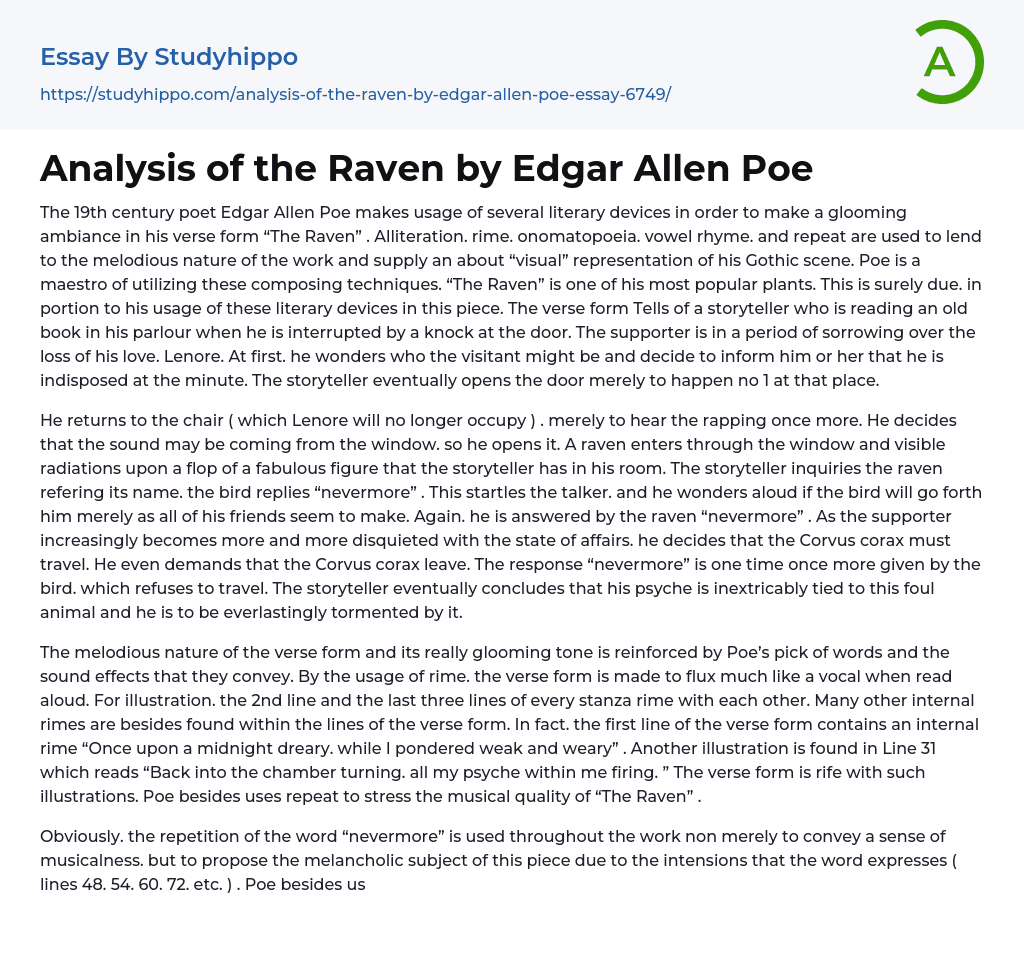The poet Edgar Allen Poe, in his poem "The Raven," uses various literary devices such as alliteration, rhyme, onomatopoeia, vowel rhyme, and repetition to create a gloomy atmosphere. These techniques contribute to the musical nature of the work and visually depict his Gothic scene. Poe is a skilled writer who effectively utilizes these techniques, making "The Raven" one of his most popular works. The poem tells the story of a narrator who is reading in his parlor when interrupted by a knock at the door. The narrator is grieving over the loss of his love, Lenore. At first, he wonders about the identity of the visitor and decides to inform them that he is unavailable. Eventually, the narrator opens the door to find no one there. Returning to his seat, he hears the knocking once
...more. Thinking it may be coming from the window, he opens it, and a raven enters and perches on a bust of a mythical figure in his room. The narrator questions the raven about its name, and the bird responds with the word "nevermore." This startles him, and he wonders aloud if the bird will leave him like all his friends have done. Once again, the raven replies with "nevermore."The narrator increasingly becomes more and more disturbed with the state of affairs, resulting in his demand for the Corvus corax to leave. However, the bird responds with "nevermore," refusing to go. The narrator concludes that he is forever connected to this bird and will be tormented by it. Poe's choice of words and sound effects reinforce the dark tone and melodic nature of the poem. The use of rhyme i
the poem creates a flowing effect, similar to a song when read aloud. Internal rhymes are found throughout the poem, including the first line which contains an internal rhyme of "Once upon a midnight dreary, while I pondered weak and weary." Another example can be seen in Line 31 with "Back into the chamber turning, all my soul within me burning." The poem is filled with such examples. Poe also utilizes repetition to emphasize the musical quality of "The Raven." The repetition of the word "nevermore" not only adds a sense of musicality but also suggests the melancholic theme of the poem (lines 48, 54, 60, 72, etc.). Poe also incorporates repetition in other sections of the poem.In lines 16 and 17, the speaker mentions a visitor waiting at his door, suggesting he wants to convince himself it is not a sinister force, but merely a guest. Edgar Allen Poe skillfully uses words that not only enhance the flow of the work, but also reinforce the tone. Throughout "The Raven," alliteration, the repetition of starting sounds, is used frequently. An example of alliteration is seen in line 26, where the "d" sound is repeated: "Doubting, dreaming dreams no mortal ever dared to dream before." Another example is found in line 45: "'Though thy crest be shorn and shaven, thou,' I said, 'art sure no craven.'" In the previous examples, the "th" and "sh" sounds are used for effect. Vowel rhyme, the repetition of vowel sounds in a line, is also cleverly employed by Poe. Line 13 gives an example of vowel rhyme as Poe pairs the words "...purple curtain." Immediately after, in line 14, he
starts with the assonant words "Thrilled me-filled me..." Again, we see this choice of words in line 59: "...hopes have flown..." However, line 71 provides perhaps one of the clearest examples of Poe's use of vowel rhyme when he writes "...grim, ungainly."In "The Raven," Edgar Allan Poe skillfully employs onomatopoeia, a technique that uses words imitating the sounds they describe. Examples can be found in the descriptions of the "rapping" and "tapping" on the speaker's door and window (lines 3, 4, 5, 21, 22, and 32). Poe also utilizes onomatopoeia in line 37 when he describes the raven's entrance as a "flirt and flutter" from the window. Another fine example is found in line 80, where the author mentions the "tinkle" of footsteps on the floor. "The Raven" illustrates how authors can use sound effects and other literary devices to create a tone that evokes a specific mood in readers. Poe's mastery of these tools is truly impressive as he provides an example to authors, readers, and students on how to effectively utilize them to convey the sense of apprehension desired while maintaining the beauty of a flowing, melodious poem.
- Boo Radley essays
- Genesis essays
- Richard iii essays
- Alice in Wonderland essays
- On the road essays
- Ozymandias essays
- The Nightingale essays
- Holden Caulfield essays
- Animal Farm essays
- 1984 essays
- A Hanging essays
- Shooting An Elephant essays
- A Tale Of Two Cities essays
- Adventures Of Huckleberry Finn essays
- Arthur Conan Doyle essays
- Brave New World essays
- Characters In Hamlet essays
- Characters In Romeo And Juliet essays
- Desdemona essays
- Diary Of A Wimpy Kid essays
- First-Person Narrative essays
- Frankenstein essays
- Heart Of Darkness essays
- Jane Eyre essays
- Jay Gatsby essays
- King Duncan essays
- Librarian essays
- Little Red Riding Hood essays
- Lord Of The Flies essays
- Silas Marner essays
- The Cask Of Amontillado essays
- The Catcher In The Rye essays
- The Crucible essays
- The Handmaid's Tale essays
- The Reader essays
- Virgil essays
- Wuthering Heights essays
- Candide essays
- Castle essays
- J. D. Salinger essays
- Ulysses essays
- Ethan Frome essays
- In Cold Blood essays
- Outliers essays
- Tuesdays With Morrie essays
- The Art of War essays
- Wife of Bath essays
- Huckleberry Finn essays
- The Lady With The Dog essays
- Great Expectations essays




